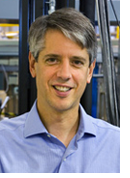Welcome Back!
 I want to express my best wishes for all members of the ALS community and their families for a happy and productive new year. It will certainly be a challenging and busy time in Building 6 as we move forward with many new projects, including
I want to express my best wishes for all members of the ALS community and their families for a happy and productive new year. It will certainly be a challenging and busy time in Building 6 as we move forward with many new projects, including
- the construction of new beamlines (e.g., MAESTRO in sector 7);
- improvements to the accelerator (a major controls system upgrade and the sextupole magnet project);
- exciting new proposals to the funding agencies (e.g., energy research in Sector 8);
- infrastructure improvements (new roof and HVAC controls);
- a streamlined user processing system for proposals and other data.
The list of ALS renewal projects will only continue to grow in the coming years.
While we have received funding for most of these projects, we are also looking at a particularly uncertain budget climate in Washington. We have prepared contingencies, but I’ve learned to expect surprises. Our response to the ups and downs in funding has been not only to consider and plan for many scenarios, but also to proactively partner with others for support of our activities, including other Lab divisions, departments on the Berkeley campus, other national laboratories, and even private foundations. This allows us to broaden our resource base, and has the additional benefit of broadening our scientific vision.
As I write this note, we have just closed out a hugely successful workshop hosted by LBNL, “Biology with FELs: Toward the Molecular Movie.” Long-time ALS user John Spence, from Arizona State University, put together a remarkable group of 150 scientists, including international leaders in biology and x-ray free electron laser (FEL) science and technology. The talks and discussions focused on what x-ray FELs are bringing, and could bring, to the field of imaging and to biology broadly. We heard about the recent success of nanocrystallography and single object imaging at the newly operating x-ray FEL source, LCLS, at SLAC. We also heard about light source properties and the related technologies needed for a next generation x-ray laser. Importantly, the results of this workshop will inform design considerations regarding a potential next generation light source x-ray FEL, under consideration at Berkeley Lab, as we expand our own capabilities and facilities for photon science.
I want to thank our users for communicating all of their excellent publications in preparation for our major review by the DOE in March. This triennial review focuses on our scientific productivity, and I’m very pleased by the response of our users and staff in helping to make sure we can tell the full story in this critical metric. Of course, our productivity was enabled by a great year for operations at the ALS (greater than 95% reliability of the beam), as well as an excellent safety culture and the traditionally helpful attitude of everyone on our skilled ALS staff. I especially want to thank those who selflessly helped out during the Lab’s Open House, when we showed off the ALS to over 1200 visitors!
Finally, I consider the opening of our wonderful User Support Building to be a harbinger of the health and vitality of the ALS. Every time I walk through Building 15, or go to a seminar, or visit someone in the labs, offices, or cubicles there, I feel grateful for both the confidence of the DOE and the investment that the nation has made. Mostly, I am very proud of the people at the ALS, since it is in our staff and broader community for which the DOE has shown its support, and for whom its investment for the future is being made.